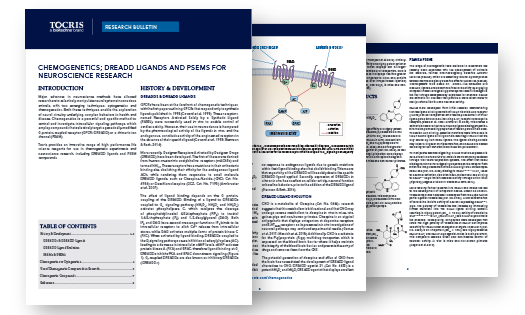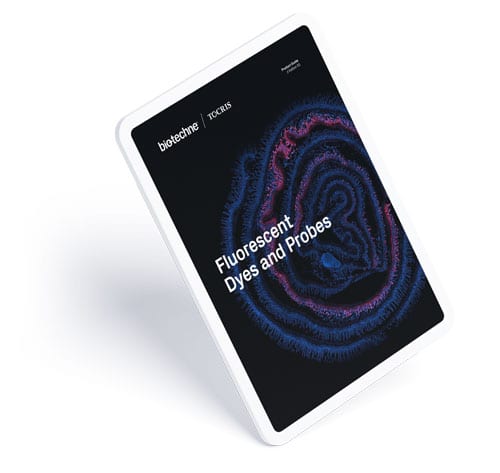电生理学产品
GPCR 配体
GPCR 配体
G 蛋白偶联受体 (GPCR) 是介导多种肽、激素和神经递质的下游信号传导的膜蛋白。作用于 GPCR 的化合物能够操纵信号通路和相关生物反应。
在上方搜索栏中搜索您的靶标,或通过点击下方链接在 tocris.com 上浏览药理学分类
化学遗传学
化学遗传学
化学遗传化合物能够通过选择性靶向基因修饰的 GPCR(DREADD 和 DREADD 配体)或工程化嵌合离子通道(PSMA 和 PSEM)的小分子来控制兴奋性细胞的活性。DREADD 配体还可用于研究 GPCR 激活下游的信号通路。
利用 FFN 对突触活性成像
荧光假神经递质 (FFN) 是神经递质转运体的荧光底物,如 VMAT2 和 NET。荧光假神经递质可标记表达转运体的神经元和突触囊泡,并能够对培养神经元和体内突触囊泡的神经递质释放和胞吐活动进行成像和跟踪。
FFN 200(货号 5911)用于对培养的多巴胺能神经元轴突中的囊泡簇,以及高钾刺激下的囊泡胞吐进行成像(延时成像,每分钟 12 幅图像)。
电生理学资源
《化学遗传学研究通报》
《化学遗传学研究通报》
《化学遗传学研究通报》由我们内部专家编制,其中介绍了体外和体内调控神经元活性的化学遗传学方法。讨论了基因修饰受体和离子通道的开发,包括 RASSL、DREADD 和 PSAM,以及化学遗传化合物的使用。
《荧光探针和染料产品指南》
《荧光探针和染料产品指南》
我们的《荧光探针和染料研究指南》提供了荧光探针和染料使用的背景信息,以及我们的全面产品系列清单,包括:
- 荧光染料,包括用于流式细胞术的染料
- 荧光探针
- 生物发光底物
- 适用于核酸适配体的荧光染料
- 用于成像细菌的荧光探针
- 用于增强 IHC、ICC 和 FISH 信号的 TSA 试剂
电生理学相关研究用产品
GPCR 抗体
GPCR 抗体
众所周知,尽管 GPCR 是最大的整合膜蛋白家族,并且在信号转导中起到关键作用,但开发用于检测 GPCR 的抗体却困难重重。R&D Systems 对 GPCR 抗体的专业知识行业领先,值得您的信赖。
从广义上讲,电生理学是测量通过细胞膜、组织或整个器官内的电流。电生理学作为一种生物医学研究技术广泛应用于神经科学和心血管研究领域,分别用于研究中枢或外周神经元和心肌细胞的电特性。然而,电生理学方法也可用于微生物学领域,例如研究细菌中的离子通道,或用于内分泌学领域,例如研究胰岛 β 细胞的兴奋性。
电生理学技术可用于多种实验情况,具体取决于所进行的研究。在体外研究中,膜片钳可用于研究细胞、离体全细胞或干细胞衍生细胞中内源性或人工表达的细胞膜、具体离子通道或受体的分离部分。此外,在神经科学研究中,也可使用保存在人工脑脊液 (aCSF) 中的脑片。在体内研究中,电生理技术利用单电极或多电极阵列测量局部场电位信号,还可以通过全细胞膜片钳研究单个神经元的活性。
所有类型的电生理学实验都会用到小分子,例如,操纵和研究单个离子通道或受体的功能;探索转运体或酶抑制在分子、细胞或系统水平方面的生理影响;以及改变单个细胞或细胞群的活性,并研究这些细胞与大脑其他区域的关联性。
“膜片钳”是一种用于细胞内记录的电生理技术。该技术由伯特•沙克曼和埃尔温•内尔于 20 世纪 70 年代末开发,用于研究分离细胞或细胞膜“膜片”中的离子流(离子电流)的变化。有两种不同的膜片钳技术:电压钳技术,该技术控制跨膜电压并记录由此产生的电流变化;以及电流钳技术,该技术控制通过膜的电流并测量电压变化。在神经元中,电压变化表现为动作电位。
在膜片钳实验中,将装有电解质溶液的微量移液管和记录移液管与细胞膜接触。所用的电解质溶液取决于进行记录的类型和确切的实验设置。大多数膜片钳实验在体外进行,但这项技术的最新进展使研究人员能够对接受镇静剂或处于清醒状态且头部固定的啮齿动物进行体内全细胞膜片钳实验。此外,机器人和自动化技术的发展为开发用于高通量筛选实验的膜片钳方法提供了支持。
膜片钳的类型
- 细胞贴附式膜片,即微量移液管与细胞膜形成密封,但细胞膜保持完整且未刺破细胞。这样可以记录通过微量移液管末端细胞膜“膜片”通道的离子电流。小分子包含在移液管电解质溶液中,以调节正在研究的离子通道或 GPCR 的功能。
- 膜内面向外膜片,即与微量移液器相连的膜片与细胞的其他部分分离。这种记录形式支持操纵膜的细胞内表面环境。
- 全细胞膜片,即附着到细胞后,通过微量移液管抽吸,刺穿细胞膜,使移液管内部接触到细胞内部。这种记录形式允许同时通过多个通道记录电流。
- 膜外面向外膜片,即完成全细胞膜片设置后,将微量移液管从细胞上提起,得到膜片分离部分。这部分膜片与细胞的其他部分分离,但边缘连接在一起,在移液管末端形成一个囊泡。囊泡包被电极,细胞膜的原始外表面朝向电极外。这种记录形式允许将小分子通过实验浴液施加到膜的外表面,或通过电极溶液施加到内表面。
测量个体神经元体内的活性也称为单一单元记录,可通过使用尖端尺寸约 1 µm 的微电极来实现。以这种方式记录的动作电位信号与通过细胞内电生理方法记录的信号具有相似特征,尽管信号较弱。在评估神经元活动、脑结构和功能,以及行为之间的关系时,单一单元记录可以提供更高的空间和时间分辨率。DREADD(只由设计药物激活的设计受体)和 DREADD 配体是广泛用于控制体内神经元活动的工具。DREADD 是经过基因改造的 GPCR,其对内源性化合物无反应。在细胞中表达时,可以通过 DREADD 配体进行控制,从而实现对神经信号的精准控制和研究。
体内电生理学技术还能够记录细胞外局部场电位信号 (LFP),这是由研究组织中单个细胞的同步电活动产生的瞬时电信号。信号通过放置在生成信号的细胞附近的电极进行记录,所测量的信号反映了距离电极末端约 50-350 µm 的多个细胞的动作电位信号总和。这种形式的电生理学记录通常被称为多单元记录。
神经科学领域体内电生理学实验硬件的最新技术,使研究人员能够同时测量大脑多个区域或特定大脑区域内多个部位的 LFP。这些最新技术包括使用在电极杆上以一定间隔排列的多个记录位点记录电极,以及可以长期植入允许长期测量神经元活动的多电极阵列 (MEA)。研究人员利用 MEA 研究大脑区域的活性与动物模型中的生理和行为结果的关系。








